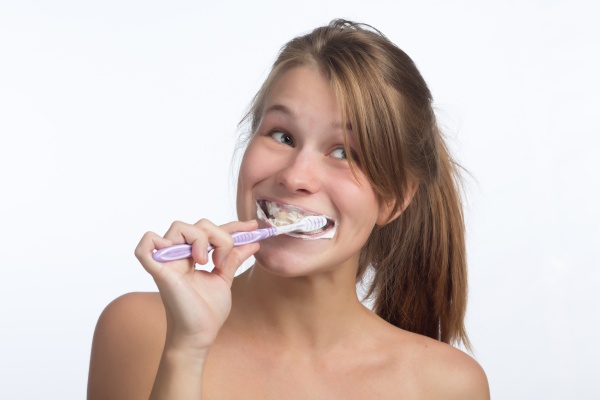Ask a Dentist: Is It Possible to Over-Brush Your Teeth?

A dentist is the best person to talk to if you want to find out whether you may be over-brushing your teeth. Brushing is an important part of good oral hygiene, but it can be overdone. When you brush too much, you wear away teeth enamel and gum tissue. This often leads to receding gums and increased tooth sensitivity.
How over-brushing occurs
If a person has a habit of brushing too hard, that can wear down teeth enamel and cause receding gums. This leaves sensitive teeth roots exposed. Receding gums can lead to other oral issues like cavities developing on teeth roots and periodontal disease. The Wall Street Journal states that about 20% of people in the U.S. have damaged their gums or teeth due to over-brushing.
The most likely people to damage their teeth and gums due to over-brushing are those who have good oral hygiene habits and use a medium or hard-bristle toothbrush. Other factors like bruxism, past orthodontic treatments and a person's genetics can affect their likelihood of damaging their teeth from over-brushing.
There is never a good reason for a person to brush their teeth vigorously. All that energy is not needed to remove plaque from teeth surfaces, and tartar cannot be removed by brushing regardless of how hard the person does it. What a person should aim for when brushing is doing it thoroughly. The toothbrush should go over all teeth surfaces, the areas when teeth and gums meet and the tongue.
Brushing correctly
Learning how to brush properly goes a long way when it comes to minimizing the effects of over-brushing. If the person's teeth have already been damaged by over-brushing, the dentist can use composite resins to fix the person's teeth.
How to brush properly
Brushing the right way is what matters, not how hard it is done. Generally speaking, dentists recommend brushing teeth for at least three minutes. Here's how a person can get the most out of each brushing session:
- Use a soft-bristled toothbrush. This is less likely to damage teeth enamel and soft tissues
- Keep the toothbrush angled towards the gums. It helps to clean the areas where teeth and gums meet
- Use short strokes when brushing. Soft circular scrubbing motions are recommended
- The force used to brush should be just enough to feel the bristles on the gums
By using the proper technique to clean teeth, plaque is removed without causing any damage to teeth enamel or the gums. As a result, the person has a cleaner, healthier mouth. Combine good brushing technique with daily flossing and antiseptic mouthwash for a more complete clean.
The bottom line
Our dental health team is experienced with treating oral problems caused by over-brushing, like damaged gum tissue or teeth enamel. We can also help you get rid of the symptoms of these issues like increased sensitivity and toothaches. Contact our clinic for an evaluation today.
Request an appointment here: https://smilesonmichigan.com or call Smiles On Michigan at (312) 509-9492 for an appointment in our Chicago office.
Check out what others are saying about our services on Yelp: Read our Yelp reviews.
Recent Posts
A smile makeover may be the answer for people who are embarrassed to show their teeth. A makeover consists of one or more dental procedures that treat or cover up imperfections with the gums or teeth. There are various methods that a dentist may use to change the appearance of one's smile, and they range…
Invisalign® is a discreet teeth-straightening method. Research shows that many people prefer this method to traditional braces. The clear aligners offer a more comfortable way to align teeth. Knowing when to choose Invisalign can help you prepare for your upcoming appointments.The metal wires and brackets of traditional braces can cause scrapes and holes in the…
Dental bonding is a reversible dental procedure that involves using a composite resin material to rebuild and restore teeth. The composites used can be matched with the color of the patient’s teeth, allowing restorations made with them to blend in.Dental bonding has cosmetic and restorative uses in dentistry. Unlike other popular restorations dentists use, its…
Wondering what a cosmetic dentist can do for your smile? Read on to learn more. A great smile can be a big self-esteem booster and a way to leave good first impressions. However, not all people have an aesthetically pleasing smile. Fortunately, a cosmetic dentist can help you improve the appearance of your teeth, gums,…